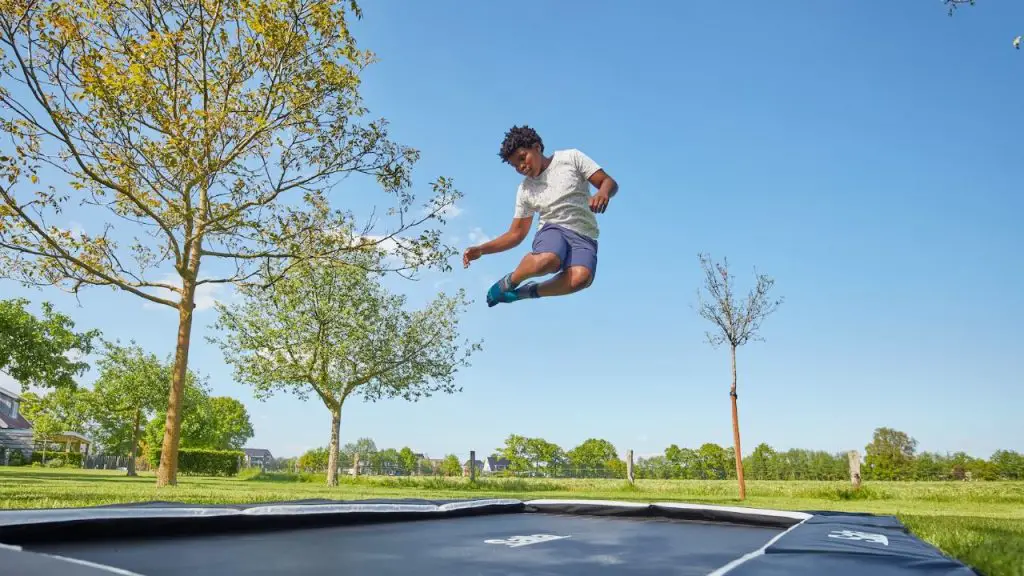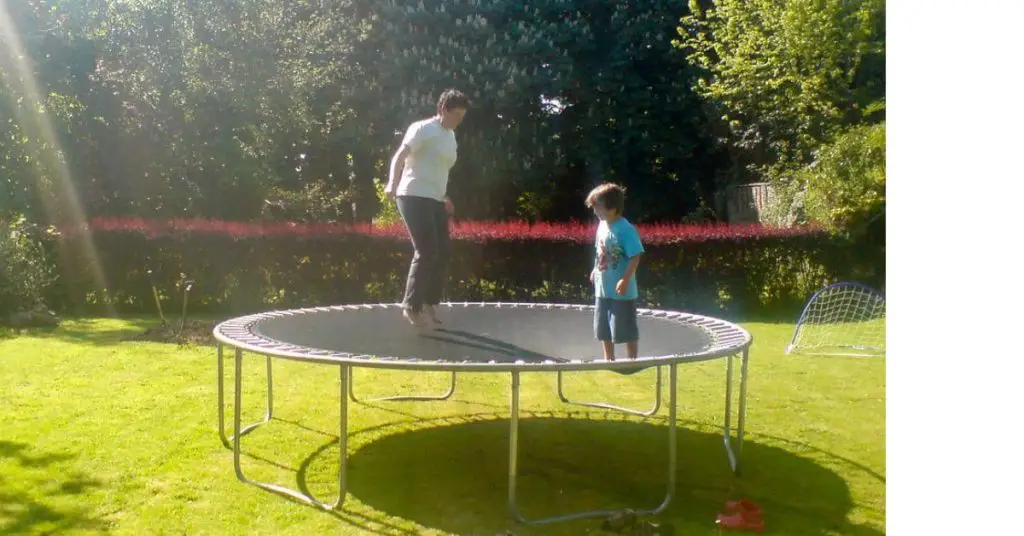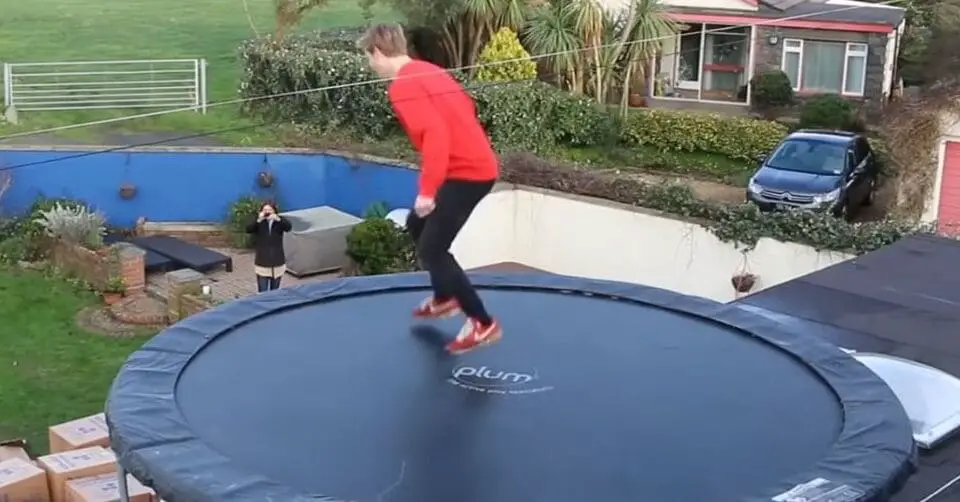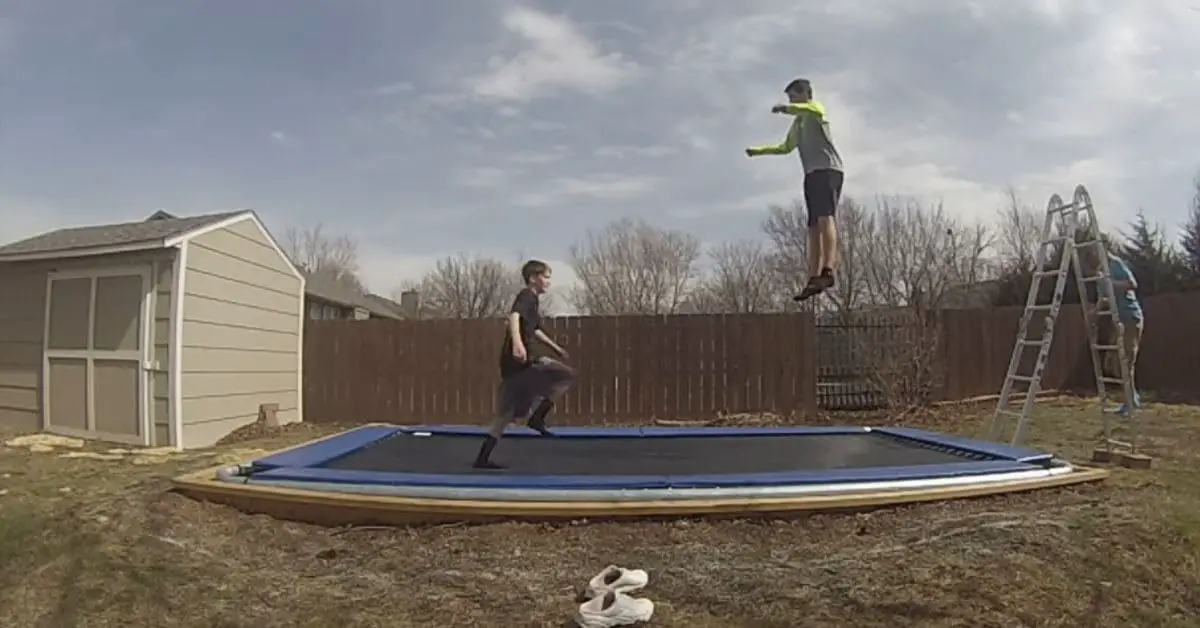I know the exhilarating feeling of soaring high into the air with each jump. But if you’re like me, you may have found yourself wondering how to jump even higher. After doing some research and practice, I’ve discovered several tips and techniques that can help you achieve greater height on a trampoline.
First and foremost, it’s important to understand the mechanics of a trampoline jump. The way you position your body and use your momentum can greatly impact your jumping height. Additionally, incorporating warm-up exercises and building strength and conditioning through specific exercises can help increase your jumping height over time.
The technique is also crucial when it comes to jumping higher on a trampoline. Proper jumping form and specific techniques, such as the “seat drop” and “piking,” can help you achieve greater height and control during your jumps.
While jumping higher on a trampoline can be a lot of fun, it’s important to prioritize safety. Always follow safety guidelines and take precautions to avoid injury.
With these tips and techniques in mind, you’ll be able to take your trampoline jumping to new heights.
How to jump higher on a trampoline: If you’re looking to increase your jumping height on a trampoline, there are a few key things to keep in mind. Understanding the mechanics of a trampoline jump and incorporating warm-up exercises and strength-building exercises can help.
Proper technique, including body positioning and specific jumping techniques, can also make a big difference. And, of course, safety should always be a top priority. With practice and persistence, you can achieve greater heights on the trampoline.
How to jump higher on a trampoline?

If you want to jump higher on a trampoline, there are several things you can do to improve your technique and build strength. Here are some tips to help you increase your jumping height:
Warm up properly: Before jumping on the trampoline, make sure to warm up your muscles with stretches or light exercises to prevent injury.
Focus on your body position: To get the most height from each jump, focus on keeping your body straight and using your legs to generate power.
Use your arms: As you jump, swing your arms up to help generate momentum and increase your jumping height.
Incorporate jumping techniques: Certain techniques, such as the “seat drop” and “piking,” can help you achieve greater height and control during your jumps.
Build strength and conditioning: Incorporate exercises that build leg and core strength, such as squats and planks, to help increase your jumping height over time.
Understanding the Mechanics of a Trampoline Jump
Trampolines are a great way to have fun and get some exercise. Whether you are a beginner or an experienced jumper, understanding the mechanics of a trampoline jump can help you get the most out of your experience. In this article, we will explore the physics behind a trampoline jump, describe how to use this knowledge to jump higher and identify common mistakes to avoid when trying to jump higher.
physics behind a trampoline jump
To understand how a trampoline jump works, we need to understand the concept of energy transfer. When you stand on a trampoline, your weight compresses the surface of the trampoline mat. This compression creates potential energy, which is stored in the springs of the trampoline.
When you jump on the trampoline, you transfer this potential energy to kinetic energy, which is the energy of motion. As you push down on the trampoline mat, the springs stretch and store energy. When you release your energy, the springs push back and propel you into the air.
The height of your jump depends on several factors, including your weight, the strength of the trampoline springs, and the amount of force you apply to the trampoline mat. To jump higher, you need to maximize the transfer of potential energy to kinetic energy.
How to use this knowledge to jump higher?
Now that we understand the physics behind a trampoline jump, let’s explore some tips on how to use this knowledge to jump higher.
Use your legs to generate power
Your leg muscles are the largest and strongest muscles in your body, and they play a crucial role in generating power for your jump. To jump higher, you need to bend your knees and use your leg muscles to push down on the trampoline mat. This will compress the springs and store potential energy, which will be released as kinetic energy when you jump.
Tuck your legs during the jump
As you jump, bring your knees up toward your chest and tuck your legs in. This will help you conserve your momentum and increase your rotational speed, which will allow you to jump higher.
Use your arms to propel yourself higher
Your arms can also help you generate power for your jump. As you jump, swing your arms upward and reach for the sky. This will help you gain extra height and momentum.
Practice rebound jumps
Rebound jumps involve bouncing up and down on the trampoline without leaving the surface. This exercise can help you build up your leg muscles and improve your jumping technique, which can lead to higher jumps.
Common mistakes to avoid when trying to jump higher

Now that we know how to jump higher, let’s identify some common mistakes to avoid.
Over-jumping and losing control
Jumping too high can cause you to lose control and land awkwardly on the trampoline mat. To avoid this, focus on maintaining a steady rhythm and not over-jumping.
Leaning too far forward or backward
Leaning too far forward or backward can also cause you to lose control and fall off the trampoline. To avoid this, focus on keeping your body centered and balanced.
Focusing too much on height and not enough on form
Finally, it’s important to remember that jumping higher is not just about height. Proper form and technique are also essential for a successful and safe jump. Make sure you focus on your technique and form as you practice your jumps.
Warm-Up Exercises
Warming up before jumping on a trampoline is an important part of any exercise routine. Not only can it help prevent injuries, but it can also improve your jumping height and overall performance. In this article, we will explore why warming up is important and provide some specific warm-up exercises that can help improve jumping height.
Why warming up is important
Warming up is important because it prepares your body for the physical demands of jumping on a trampoline. When you warm up, your heart rate and breathing increase, which helps deliver oxygen and nutrients to your muscles. This increased blood flow also helps warm up your muscles, making them more flexible and less prone to injury.
Warming up can also help improve your jumping height by activating the muscles you need for jumping. By performing specific warm-up exercises, you can activate the leg and core muscles needed for jumping and improve your overall jumping performance.
Specific warm-up exercises that can help improve jumping height
Here are some specific warm-up exercises that can help improve your jumping height:
Jumping jacks
Jumping jacks are a great way to warm up your entire body and get your heart rate up. Start by standing with your feet together and your arms at your sides.
Jump up and spread your legs apart while simultaneously raising your arms overhead. Jump back to the starting position and repeat for 20 to 30 repetitions.
High knees
High knees are a great way to warm up your leg muscles and improve your jumping height. Start by standing with your feet hip-width apart.
Lift your right knee up toward your chest, and then quickly switch to lift your left knee up toward your chest. Repeat for 20 to 30 repetitions.
Butt kicks
Butt kicks are another great way to warm up your leg muscles and improve your jumping height. Start by standing with your feet hip-width apart. Lift your right heel up toward your buttocks, and then quickly switch to lift your left heel up toward your buttocks. Repeat for 20 to 30 repetitions.
Squats
Squats are a great way to warm up your leg and core muscles and improve your jumping height. Start by standing with your feet hip-width apart. Bend your knees and lower your hips down toward the ground, keeping your chest lifted and your back straight. Straighten your legs to return to the starting position and repeat for 10 to 15 repetitions.
Lunges
Lunges are another great way to warm up your leg muscles and improve your jumping height. Start by standing with your feet hip-width apart. Step your right foot forward and lower your body down until your right thigh is parallel to the ground.
Push through your right foot to return to the starting position and repeat on the left side. Repeat for 10 to 15 repetitions on each side.
Technique Tips
When it comes to jumping on a trampoline, proper technique is crucial for maximizing your jumping height and reducing the risk of injury.
we will explore proper jumping techniques and provide some techniques that can be used to increase jumping height, as well as common mistakes to avoid when attempting these techniques.
Proper jumping technique

The proper jumping technique involves a combination of body control, timing, and coordination. Here are the key elements of proper jumping technique:
Start with a controlled bounce
Begin by bouncing gently on the trampoline, keeping your feet shoulder-width apart and your knees slightly bent. As you bounce, focus on maintaining control of your body and keeping your movements smooth and fluid.
Use your arms
Your arms play a crucial role in jumping on a trampoline. As you bounce, swing your arms up and overhead, and then bring them back down to your sides as you land. This helps to generate more upward momentum and can help increase your jumping height.
Use your legs
As you swing your arms up, push down with your legs to generate more upward momentum. Keep your knees slightly bent and use the power of your leg muscles to launch yourself higher into the air.
Keep your core engaged
Engaging your core muscles can help you maintain better control of your body and improve your jumping height. Focus on tightening your abdominal muscles as you jump, and keep your torso stable and upright.
Techniques that can be used to increase jumping height
Here are some techniques that can be used to increase your jumping height:
Tuck jumps

Tuck jumps involve bringing your knees up to your chest as you jump, which can help you generate more upward momentum. To perform a tuck jump, start by bouncing gently on the trampoline. As you bounce up, bring your knees up to your chest, and then extend your legs back out as you land.
Seat drops
Seat drops involve dropping down onto your bottom as you bounce, which can help you generate more upward momentum. To perform a seat drop, start by bouncing gently on the trampoline.
As you bounce up, tuck your legs in and drop down onto your bottom. As you bounce back up, extend your legs back out.
Half-twists
Half-twists involve twisting your body halfway around as you jump, which can help you generate more upward momentum. To perform a half-twist, start by bouncing gently on the trampoline.
As you bounce up, twist your body halfway around and land facing the opposite direction. As you bounce back up, twist your body back around to face the original direction.
Common mistakes to avoid when attempting these techniques
Here are some common mistakes to avoid when attempting these techniques:
Over-rotating
When attempting tuck jumps or seat drops, it’s important to avoid over-rotating and landing on your back. To avoid this, focus on keeping your eyes on the trampoline and using your arms and core muscles to maintain control of your body.
Not using your arms
Your arms play a crucial role in generating upward momentum when jumping on a trampoline. Make sure to swing your arms up and overhead as you jump to help generate more height.
Not engaging your core
Engaging your core muscles can help you maintain better control of your body and improve your jumping height. Make sure to tighten your abdominal muscles as you jump to help stabilize your torso.
Building Strength and Conditioning
Related article: How To Repair Trampoline Net
If you want to jump higher on a trampoline, building strength and conditioning is key. Not only will it help you generate more upward momentum, but it can also reduce the risk of injury and improve overall performance.
we’ll explore why building strength and conditioning is important for jumping higher, and provide a variety of exercises that can help you build the necessary strength and conditioning.
Why is building strength and conditioning important for jumping higher?
Jumping on a trampoline requires a combination of strength, power, and endurance. Building strength and conditioning in these areas can help you generate more upward momentum and sustain that momentum for longer periods of time.
Here are some of the key benefits of building strength and conditioning for jumping higher on a trampoline:
Increased power
Building leg and core strength can help you generate more power when jumping on a trampoline. This increased power can translate to greater height and more explosive jumps.
Improved endurance
Jumping on a trampoline can be physically demanding, especially when attempting to jump higher. Building endurance through cardiovascular exercise and endurance-based strength training can help you sustain your jumps for longer periods of time.
Reduced risk of injury
Jumping on a trampoline can be risky, especially when attempting to jump higher. Building strength and conditioning can help reduce the risk of injury by improving joint stability and muscle control.
Necessary strength and conditioning for jumping higher on a trampoline?
Here are some exercises that can help you build the necessary strength and conditioning for jumping higher on a trampoline:
Squats

Squats are a great exercise for building leg strength, which is crucial for generating power when jumping on a trampoline. To perform a squat, stand with your feet shoulder-width apart, toes pointing forward. Lower your body down by bending your knees and pushing your hips back, keeping your chest upright. Return to the standing position and repeat.
Lunges
Lunges are another great exercise for building leg strength and improving balance and coordination. To perform a lunge, start by standing with your feet hip-width apart.
Take a big step forward with one foot, bending your front knee and lowering your body down towards the ground. Return to the standing position and repeat on the other side.
Jump squats
Jump squats are a plyometric exercise that can help improve explosive power and endurance. To perform a jump squat, start by performing a regular squat, but as you come up, jump off the ground and land softly back down into a squat position. Repeat for multiple reps.
Planks
Planks are a great exercise for building core strength, which is important for maintaining proper form and generating power when jumping on a trampoline. To perform a plank, start in a push-up position with your arms straight and hands shoulder-width apart.
Hold this position for as long as you can, making sure to keep your core engaged and your body in a straight line.
Burpees
Burpees are another great plyometric exercise that can help build explosive power and endurance. To perform a burpee, start in a standing position. Lower your body down into a push-up position, perform a push-up, and then jump your feet back up towards your hands. Jump up off the ground and land softly back down in a standing position. Repeat for multiple reps.
Safety Considerations
While jumping on a trampoline can be a fun and exhilarating activity, it can also be dangerous if proper safety precautions are not taken. When attempting to jump higher on a trampoline, there are additional risks involved that should be taken seriously.
we’ll explore the potential risks involved with jumping higher on a trampoline and provide some safety precautions that should be taken to avoid injury.
Potential risks involved with jumping higher on a trampoline
Here are some of the potential risks involved with jumping higher on a trampoline:
Falls and Impact Injuries
When attempting to jump higher on a trampoline, there is an increased risk of falls and impact injuries. If you fall off the trampoline or land awkwardly, you can injure yourself by hitting the ground or landing on a hard surface.
Sprains and Strains
Jumping on a trampoline requires a significant amount of physical exertion, which can put a strain on your joints and muscles. If you attempt to jump higher than your body is capable of, you risk sprains and strains in your ankles, knees, and other joints.
Collisions
If multiple people are jumping on the trampoline at the same time, there is an increased risk of collisions. Collisions can cause serious injuries such as concussions and broken bones.
Safety precautions that should be taken to avoid injury
Here are some safety precautions that should be taken to avoid injury when jumping higher on a trampoline:
Supervision
Make sure that someone is supervising the trampoline at all times. This person should be responsible for enforcing safety rules and ensuring that everyone is following them.
One Person at a Time
Only one person should be on the trampoline at a time. This will reduce the risk of collisions and ensure that each person has enough space to jump safely.
Proper Clothing
Wear appropriate clothing when jumping on a trampoline. Loose clothing can get caught in the springs or on other objects, causing falls or other injuries. It is also important to wear shoes with good traction to prevent slips and falls.
Proper Use
Follow the manufacturer’s instructions for proper use of the trampoline. Make sure that the trampoline is set up correctly and that all safety features such as nets and pads are in place.
Warm-Up and Cool-Down
Before jumping on the trampoline, warm up with some light stretching and cardio exercises. This will help prepare your body for the physical demands of jumping. After jumping, cool down with some light stretching to prevent muscle soreness and stiffness.
Avoid Dangerous Tricks
Avoid attempting dangerous tricks such as flips and somersaults. These tricks can cause serious injuries and should only be attempted by trained professionals in a controlled environment.
FAQs
Q.1 Can I increase my jumping height on a trampoline?
Yes, there are several techniques and exercises that can help you increase your jumping height on a trampoline.
Q.2 Will wearing shoes help me jump higher on a trampoline?
Wearing shoes with good traction can help you grip the trampoline surface better, which may help you jump higher. However, it’s important to wear shoes that are appropriate for trampolining to avoid slipping or injury.
Q.3 How long should I jump on a trampoline to improve my jumping height?
There is no set amount of time that guarantees improvement in jumping height. Consistent practice and incorporating techniques and exercises can lead to gradual improvement over time.
Q. 4 Is it safe to add water or soap to a trampoline to increase jumping height?
Adding water or soap to a trampoline can make it slippery and increase the risk of injury. It’s not recommended to add these substances to the trampoline surface.
Q.5 Can jumping on a trampoline every day be harmful?
Jumping on a trampoline every day can be safe and beneficial if done in moderation and with proper technique. However, overuse can lead to joint or muscle injuries.
Q.6 Will my weight affect my ability to jump higher on a trampoline?
Generally, heavier people may not bounce as high on a trampoline as lighter people due to the trampoline’s weight limit. However, building strength and proper technique can still help heavier individuals achieve greater height.
Q.6 Why do trampolines make you jump higher?
The trampoline’s surface is designed to absorb your energy as you land and use it to propel you higher on your next jump. This effect is amplified with proper technique and momentum.
Conclusion
In conclusion, jumping higher on a trampoline requires a combination of proper technique, strength, and conditioning. Understanding the mechanics of a trampoline jump, including the physics behind it, can help you use that knowledge to your advantage when trying to jump higher. It’s important to warm up properly before attempting higher jumps and to avoid common mistakes that can lead to injury.
Specific warm-up exercises and techniques can be used to increase jumping height, but it’s important to also focus on building the necessary strength and conditioning through targeted exercises.
Finally, safety should always be a top priority when jumping on a trampoline, and taking the proper precautions can help prevent injuries. With these tips and techniques, you can work towards achieving higher jumps on a trampoline while minimizing the risk of injury.
We hope that this guide has helped you learn how to jump higher on a trampoline. If you have any questions, please don’t hesitate to ask by leaving a comment below!

